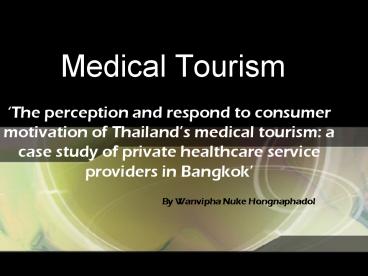Medical Tourism - PowerPoint PPT Presentation
1 / 23
Title:
Medical Tourism
Description:
The nature of seeking medical care abroad is a relatively private matter ... respondents of medical tourism to make up a significant sample size would be very ... – PowerPoint PPT presentation
Number of Views:4001
Avg rating:3.0/5.0
Title: Medical Tourism
1
Medical Tourism
The perception and respond to consumer
motivation of Thailands medical tourism a case
study of private healthcare service providers in
Bangkok
- By Wanvipha Nuke Hongnaphadol
2
Research Journey
- Project outline
- Aims of the study
- Research questions
- Objectives of the study
- Research methodology
- Potential limitations to the study
3
Project outline
- The sudden boom of medical tourism in Thailand as
a remarkable phenomenon - Europe ( e.g. Hungarydeclared 2003 as the Year
of Health Tourism, Israel, Belgium, Poland,
Greece, Spain) - South America (e.g. Costa Rica, Mexico, Brazil)
- Middle East (e.g. DubaiDubai Healthcare City by
2010, Jordan, Iran) - South Africa
- Asia (Singapore,Thailand, India, Malaysia,
Philippines)
4
Cont.
- The rise of medical tourism, as the major medical
tourism destination in Asia (Connell, 2006). - Little research of tourism has been conducted on
consumer motivation perspectives (Goossens, 2000
Bansal Eiselt, 2004).
5
Cont.
- No empirical study identifying the travel
motivation of travelers to Thailand
(Rittichainuwat et al., 2008). - Answering the question of why people travel is
the most challenging in tourist behaviour
(Crompton, 1979).
6
Aims of the study
- The present research project aims
- to reveal the underlying reasons of why consumers
traveling to Thailand for their medical treatment - to identify the application of consumer
motivation to the field of tourist motivation and
review what approaches and procedures have been
used.
7
Research Questions
- 1. What are the significant motivational motives
(push-and-pull travel motivations) that influence
foreign consumers' travel decision of the major
target markets of medical tourism to Thailand for
health care treatment? - 2. How do the health care service providers in
Thailand perceive the foreign consumer
motivation? - 3.To what extent do the health care service
providers employ the application of the perceived
consumer motivation to the field of medical
tourist motivation and respond to consumer
perceived needs?
8
Objectives of the study
- To establish a theoretical framework on the basis
of previous research in consumer motivation and
tourism motivation and a new emerging interest in
medical tourism that allows for a deeper
understanding of the underlying concepts of
medical tourists visiting Thailand - To apply this framework to the specific medical
tourist motivation context in Thailand
9
Cont.
- To identify key motivational factors of the major
target market of Thailands medical tourism - To ascertain whether the supply side (private
healthcare service providers and related
supporting stakeholders) understand the exact
needs of the demand side and whether they
effectively respond to those required
10
Introduction to Medical Tourism
- Health tourism
- A deliberate combination of health concerns and
tourism - A reversed trend
11
Stakeholders
- The Tourism Authority of Thailand
- The Private Hospital Association
- Department of Thai Exports Ministry of Commerce
12
Theoretical Framework
- Consumer motivation
- Medical tourist motivation
- Push-Pull motivational factors
13
Cont.
- The push-pull theory has prevailed other
paradigms in examining tourism motivations
underlying tourist and visitation behaviour
(Dann, 1977, 1981 Crompton, 1979). - Push motives are difficult to be explored
(Crompton, 1979). - Pull factors are more focused on in terms of the
marketing perspectives (Dann, 1981).
14
Cont.
- Push Pull
- Push (Escaping/the desire to travel) Pull
(Seeking/the choice of destination) (Iso-Ahola,
1987). - Push (whether to go) Pull (where to go)
(Klenosky, 2002). - Push (intangible intrinsic desires of tourists)
Pull (tangible characteristics/attributes of a
destination) (Kozak, 2001).
15
Methodology
- A mixed-method design of qualitative
quantitative approaches - Mixed methods result in a comprehensive
measurement in understanding tourist motivation
(Fodness, 1994). - Survey questionnaires
- In-depth interviews
- Content analysis
16
Cont.
- Measurement of push and pull factors
- Indicating agreement-disagreement
- A 5-point Likert-type scale
17
The study site
- Bumrungrad International Hospital
- Bangkok Hospital
- Criteria
- Location
- JCI accredited
- Target market
18
Potential limitations to the study
- Little academic research has been done on medical
tourism market due to its relatively new niche
market (Caballero-Danell Mugomba, 2007). - Only surgery and non-surgery treatments focused.
- The nature of seeking medical care abroad is a
relatively private matter therefore finding
respondents of medical tourism to make up a
significant sample size would be very challenging.
19
Cont.
- According to the Tourism Authority of Thailand
(TAT) and Ministry of Public Health (MPH), there
are one million medical tourists come to Thailand
a year since 2005, the real source of that figure
is still unknown. - The claimed figure of Bumrungrad International
Hospital included expatriates and by counting
every time when a patient walks into the
hospital (Comarow, 2008).
20
Figure 1 Medical Tourists Motivation to
Destination Countries
Pull
factor
- Push factor
- Physical/psychological factors
- Overburdened healthcare system in home country
- Unaffordable
- Inaccessible
Destination Country
Medical Tourist in Originating Country
Intermediarie (representative offices)
Direct
- Accessible
- High quality, low price
- Unexpected service
- Relaxation/recuperation
21
Figure 2 Health Tourism
Health Tourism
Medical Tourism
Wellness Tourism
Spa Tourism
Essential Medical Care/Illness
Preventive Medical Care
Enhancement/Beauty Surgery
Medical Check-ups Health Screening etc.
Cosmetic Surgery Sex Change Operation etc.
Heart Surgery Bypass Operation Neurosurgery Cancer
Treatment Transplants
Aromatherapy Acupuncture Massage Yoga etc.
22
Figure 3 Structure of Medical Tourism in
Thailand
Medical Tourism in Thailand
Healthcare Service Industry
Tourism Industry
Hospital Medical Service
Thai Health Spa
Thai Traditional Health Massage
Herbs
Thai Traditional and Alternative Medicine
Pharmaceutical Industry
23
- Thank you for your attention.

